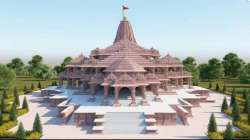Ram Mandir construction begins, to complete in next 36-40 months: A look at the action plan
The construction of Ram Temple has, finally, begun in Ayodhya. It is expected to complete in the next 36-40 months, the Shri Ram Janmbhoomi Teerth Kshetra said today.

The construction of Ram Temple has, finally, begun in Ayodhya. It is expected to complete in the next 36-40 months, the Shri Ram Janmbhoomi Teerth Kshetra said today. The shrine will be built by adhering to the country's ancient and traditional construction techniques. It will also be built to sustain earthquakes, storms, and other natural calamities. Notably, "the iron will not be used in the construction of the temple," the Trust said.
THE ACTION PLAN
- Engineers from CBRI Roorkee, IIT Madras along with L&T are testing the soil at the Ram Mandir site.
- For Mandir construction, copper plates will be used to fuse stone blocks with each other.
- The plates should be 18 inches long, 30 mm wide & 3 mm in depth.
- 10,000 such plates may be required in total structure. We call upon Shri Rambhakts to donate such copper plates to us, the trust said.
RAM MANDIR WILL STAND FOR OVER 1,000 YEARS
Only stones will be used for building the Ram Temple in Ayodhya and it will stand for over 1,000 years, Champat Rai, the General Secretary of the Shri Ram Janmabhoomi Teerth Kshetra trust said.
Rai, who is also a senior functionary of the Vishwa Hindu Parishad (VHP), said the country's best minds from IIT-Chennai and the Central Building Research Institute (CBRI) are involved in the construction process of the temple.
While Larsen & Toubro is broadly looking after the construction of temple, IIT-Chennai has been consulted for testing soil strength and CBRI services are being used to make sure the building is earthquake-resistant, he told reporters.
Around 10,000 copper rods are required for building the temple. Since people want to be a part of the construction process, they can do so by donating copper, Rai said.
Using only stones, it will be built in such a manner that decay due to air, sun and water will not happen and temple will last for at least 1,000 years, he added.
- With PTI inputs -